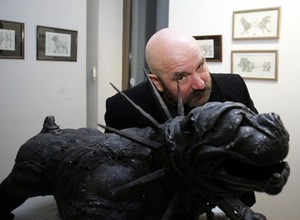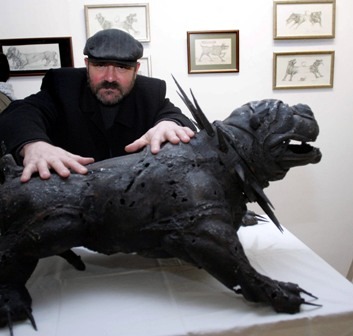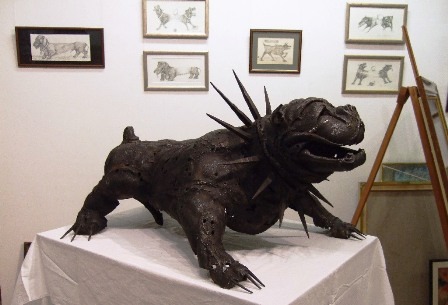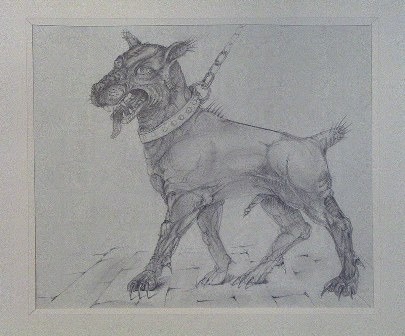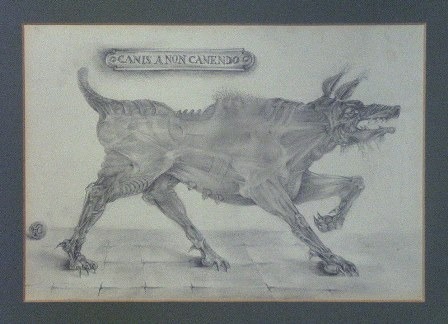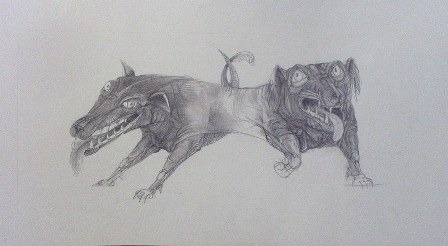IRON DRAWINGS 0
(Exhibition of Edmundas Frejus’ works “Canis a Non Canendo” at the gallery Kauno Langas) Kotryna Džilavjanaitė
www.kamane.lt, 2008 02 09
Photos by L.Brundza
Photo by K.Džilavjanaitė
Photos by L.Brundza
In brief: The name of the sculptor Edmundas Frejus is closely related with iron – even the initials of the artist pressed in his works correspond to the sign fe in the Mendeleyev table and mean ferrum – iron. Iron is the main creative substance of E.Frejus and also the exact metaphor of the strong personality.
The iron sculptures of E. Frejus balance on the border of popular aesthetics very often and have elements of kitsch; however, they always attract by mastery technique and puzzles coded in details, which may be guessed only by an erudite. Many hybrid figures may be noticed among the works of Frejus – half people, half animals born from the imagination of the sculptor. E.Frejus joins the head of the god Anubis-dog, the torso of a human being and cherub’s wings into one entity in the same manner as he melts separate pieces of cast iron.
Even though the artist does not avoid decorative details, the banal standards of beauty are not typical of his sculptures. On the contrary, he models bodies which are not perfect, the works look earthly and slightly harsh. The harmony of E.Frejus’ sculptures is based on the composition of forms, which often shocks the spectator, rather than the interpretation of a motif.
As the artist does not participate in exhibitions frequently, the exposition open at Kauno Langas gallery presenting more than a dozen of small-scale drawings and one iron sculpture generalising them became an unexpected piece of news. The exhibition “Canis a Non Canendo” is dedicated to the dog by E.Frejus. The sculptor looked critically at species of dogs which suffer from experiments of people, their wishes or some dog fashion.
A short nose restricting breathing, short legs, long ears, cut-off tail – these are unnatural features of a dog which were not typical of the ancient predecessor of a dog Canis lupus, the wolf. The impression is fortified by the dismal mood of the drawings, aggressive and frantic dog faces. The strict silhouette of a painting, constructive picturing of anatomy of the animal, emphasis on hard details creates an illusion that the drawings of E.Frejus have been cast from iron as well.
The sculpture presented in the exhibition does not fit into the limits of small sculpture and purifies the visions seen in drawings. The powerful, massive bulldog stoned in an attack pose absorbs the look by the rough facture of black iron. The stylish and formidable accents – the killing nails, collar with studs – form the image of a dog that came directly from hell.
Observing the mutant and angry dogs of E.Frejus, the feeling persists that these are the allegories of the most terrible grimaces of the humanity rather than portraits of dogs. The apocalyptic drawings express the protest against intervention with natural laws as well as the lack of sensitivity and cruelty of people. Thus, the exhibition testifies that a dog is one of the most suitable metaphors while criticising people and the society in art. No matter what means are used for this. This time E.Frejus expressed his criticism in the method usual to him – by iron.
